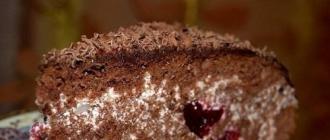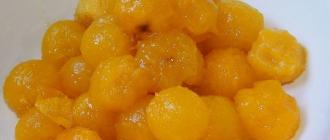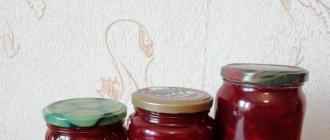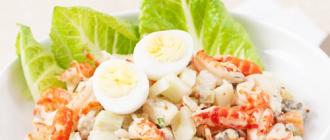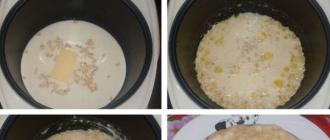Agar-agar is a natural plant analogue of gelatin. White and translucent, it is sold in the form of powder, flakes, tapes, plates. It is used to prepare various vegetarian aspic dishes, and is also added to various desserts - jellies, puddings, jams, marmalades and creams.
How to prepare agar-agar
Photo by Shutterstock
Difference between agar-agar and gelatin
One of the main differences between agar agar and gelatin is very important for those following vegetarian or vegan diets. Agar-agar is obtained from a plant source, by processing red algae of the gelidiacees family, and gelatin is obtained from animal products: leather, hooves, and tendons of cattle. Agar-agar is tasteless and odorless, and when dissolved it has no color. Another important difference is the gelling and melting temperatures. Agar-agar turns into a jelly-like mass only when mixed with water brought to a boil, cooling to a temperature of 32–43 degrees. Once frozen, agar-agar will not melt like gelatin. While gelatin can spread at room temperature, gelled agar-agar will retain its density even when heated to 85 degrees. This property of agar-agar makes it an ideal thickener and stabilizer for a variety of homemade jams, preserves, marmalades, glazes and meringues. Fans of molecular cooking know that it is agar-agar that is added to siphons to form a stable edible foam from mashed various products. Gelatin in recipes can always be replaced with agar-agar, observing the correct proportions, but it is better not to do the opposite.
Agar-agar is a stronger gelling agent, 2 grams of agar-agar can replace 6 grams of gelatin
How to dilute agar-agar
Pour 6 grams of agar-agar with 4 tablespoons of cold water and leave to swell, bring the mixture to a boil and simmer for about 5 minutes if the agar-agar is powdered and 10-15 minutes if it is in flakes, plates or ribbons. You should constantly stir the agar-agar, or better yet, beat it with a whisk or hand blender so that it dissolves without lumps and does not settle at the bottom of the pan.
On product packaging, natural agar-agar may be listed as a food additive E406
Recipe for coffee-coconut dessert with agar-agar
You will need: - 1.5 cups of coconut milk; - 1 glass of cow's milk 3.5% fat; - 1 glass of granulated sugar; - 2 tablespoons of powdered agar-agar; - 1 teaspoon of salt; - 2 tablespoons of instant coffee or cocoa; - 3 glasses of water.
Mix coconut and cow's milk with ¼ cup sugar, 1 tablespoon agar-agar and ½ teaspoon salt, let stand for about 10 minutes, whisk the mixture and bring to a boil over medium heat, boil for about 2-3 minutes and remove the pan from this mixture from the stove. Pour into the mold or ramekins of your choice. Mix the remaining sugar, agar-agar, salt, coffee and water in another saucepan, let stand, also whisk, bring to a boil and boil for 3-4 minutes. Check to see if the previous layer of jelly has hardened; if so, carefully pour in the coffee mixture. Leave the dessert for 40-45 minutes at room temperature or 20 minutes in the refrigerator. You will get a fragrant, two-color, elastic and delicious dessert.
Thickeners that thicken everything. It would seem that it’s so difficult... But no... Not everyone thickens and does not always thicken it. To get the maximum effect from each, you need to know the rules and exact proportions.
So, we tell you in order, in alphabetical order.
AGAR
aka agar-agar, aka algae thickener. It is obtained from red and brown algae by adding a certain solvent (extractant), usually alkali.
Based on quality, agar is divided into two grades: higher — color white or light yellow, a slightly grayish tint is allowed; first - color from yellow to dark yellow.
In addition, the agar is divided into density, for example: Agar M 500, Agar G 700, Agar -900, etc. The higher the number in the name, the greater the viscosity/density of the resulting gel/jelly. In proportion to the increase in density, agar consumption decreases, but its cost also increases.
Agar-agar does not dissolve at all in cold water. But it dissolves completely only at temperatures from 95 to 100 degrees. The hot solution is clear and slightly viscous. When cooled to temperatures of 35-40°, it becomes a pure and strong gel. Agar is thermoreversible, i.e. when heated to 85-95°, it again becomes a liquid solution, again turning into a gel at 35-40° degrees.
For confectioners, agar is best known as the main component of marshmallows and “Bird's milk”. But this product is loved by both those losing weight and vegetarians, because... it is of plant origin and is practically devoid of calories and is very rich in fiber, it contains a lot of carbohydrates, but no fat at all.
RULES OF USE:
Agar agar powder does not need to be pre-soaked. It is mixed with a small amount of sugar (to prevent lumps from forming) and added to hot syrup, for example, when making marshmallows.

GELATIN
Gelatin is made from bones, tendons, cartilage and other things by boiling with water for a long time. The resulting solution is evaporated, clarified and cooled until it turns into jelly, which is cut into pieces and dried. They produce sheet gelatin and powdered gelatin.
Ready-made dry gelatin is tasteless, odorless, transparent, almost colorless or slightly yellow. It swells strongly in cold water and dilute acids, but does not dissolve. Swollen gelatin dissolves when heated, forming a sticky solution that hardens into a jelly.
See how, for example, you can make a delicious decoration from gelatin - gelatin bubbles .
RULES OF USE:
Gelatin is always soaked in cold or ice water before use. Powder - in a ratio of 1 part gelatin to 6 parts water. Leaf - put in a container with water so that the water covers all the sheets 3-4 times.
Gelatin will not work well with kiwi and pineapple, because... These fruits contain a lot of enzymes that break down gelatin.
CONSUMPTION
If you want a stable jelly without a mold, take 15 grams of gelatin for every 0.6 liter liquid, then the jelly will support its own weight.
If the jelly is served in a mold, you can reduce the amount of gelatin by 15-20%. This calculation is correct for making jelly from liquid - water/juice.
When thick or semi-liquid mixtures are gelled, gelatin works differently and here the proportions have to be selected experimentally.
For example, to prepare a no-bake cheesecake from 500 grams of cottage cheese, 200 grams of sugar and 500 ml of heavy cream, 20 grams of gelatin is enough, since the cottage cheese and cream already form a fairly stable structure (when cold, of course).
Can gelatin be boiled or added to a boiling mixture? Yes, you can! It's definitely possible! Even boiling is allowed (the ratio of liquid to gelatin does not matter).

PECTIN
Pectin is an odorless powder from light cream to brown color, obtained by acid extraction from citrus fruits (lime, lemon, orange, grapefruit), apple pomace, sugar beet pulp or sunflower heads. Citrus pectins are usually lighter than apple pectins.
Confectioners usually use pectin in the production of marshmallows, jelly, marshmallows, marmalade, fruit fillings, coulis and jams. Pectin is also used in the preparation of dairy products, ice cream and even mayonnaise and ketchup.
Pectin absorbs up to 20% water, but it dissolves in excess water. Insoluble in solutions containing more than 30% dry matter. When they fall into water, the powder particles absorb it like a sponge, increasing in size several times; upon reaching a certain size, it begins to dissolve.
There are three types of pectins:
1.Yellow- cannot be re-dissolved when heated. This type of pectin is used for heat-resistant jams, confitures and marmalade; it gives the finished dish a viscous texture that distinguishes them from ordinary jam.
2.NH- is exposed to temperature and dissolves when heated, and hardens when cooled. The reversibility of pectin allows you to “play” with the texture of the puree, turning it either into a sauce or into a jelly. It is therefore ideal for sweet dessert sauces, jelly coatings and jellies, either as a stand-alone dish or as a cream layer for cakes. Adding other gelling agents, such as agar or gelatin, to a recipe using this type of pectin creates a new texture in the dish. With agar, the jelly will become more brittle and brittle, and when gelatin is added, it will become more “rubbery”.
3.FX58- interacts with products containing calcium, such as milk and cream. Therefore, it is ideal for making milk jelly and foam.
RULES OF USE
Any type of pectin must be added to the product at a temperature of 50°C, after mixing it with some sugar. This is necessary to distribute the powder evenly so that it does not seize in lumps, otherwise it will lose some of its gelling power. Moreover, sugar granules are much heavier than pectin, so there should be two to three times more of it. After adding a mixture of sugar and pectin to the liquid, you must bring it to a boil, but boil for no more than 30 seconds, and then remove from the heat and let cool. Pectin begins to act when the mixture boils, and then, as it cools, it completely completes its work. When working with yellow pectin, citric acid is added at the very end, which “starts” the gelling process. But the more acidic the environment (fruit puree or juice), the worse the pectin works.

Gelatin bubbles as a decoration for New Year's cupcakes, how to make - link in the middle of the post text:

During the ripening season of berries and fruits, many housewives make jam, wanting to preserve the fruits until winter. This delicacy is indeed tasty, aromatic and healthy, but often the finished product turns out to be liquid. To avoid such a mistake, you can use different thickeners for jam. They are added to the jam so that the product acquires a bright color and the desired consistency. Details about them are presented in the article.
Using these products is easy, and you don’t need to increase the amount of sugar to prepare the product. The fruit mass is cooked for about 10 minutes. The finished delicacy retains vitamins, the berries remain intact, and the consistency of the jam will be thick. Jam thickeners are used both in industrial settings and in home cooking. You can find various reviews from housewives regarding the use of these products, but most of them use proven methods of making the product thicker.
Choosing a container and components for jam
Every housewife knows the intricacies of preparing her dishes. This is evidenced by numerous reviews that provide tips on how to obtain delicious and healthy desserts. You can prepare jam in a copper, aluminum or enamel container. It is important that it is wide and the walls are low. Then the product heats up evenly and the liquid evaporates better.

Berries and fruits should be collected in sunny, dry weather. The fruits must be ripe and undamaged. The seeds must be removed before heat treatment of the raw materials. If the berries have a thick skin, you can pierce it with a toothpick. If the fruits have produced a lot of juice, it is recommended to drain the excess. It is better to use white sugar, not cane sugar. Moreover, it is not added immediately, but in parts.
Pectin
It is a popular thickener for jam. The word is translated from Greek as “connecting.” It has the ability to dissolve in water, followed by combination with acids and sugar without distorting their taste, so pectin is suitable for producing any gelatinous products.
This substance is a natural chemical compound found in various fruits and vegetables. The most pectin is in apples and pulp - a processed product. It is also found in citrus fruits, pumpkin, and sunflower. Apple pectin is in demand in cooking. It is created by squeezing and concentrating the apple mass, after which the intermediate product is dried. The result is a natural, plant-based polysaccharide, presented in the form of a white powder that has no odor.
Cooking properties
- Preserves the aroma of the product. cook with pectin for 10 minutes. For the standard version, when a thickener is not used, it will be necessary to spend more time on heat treatment, and the final product will not be as aromatic and with a sweeter taste.
- Berries and fruits remain intact and do not become overcooked. The jam takes on the color of fresh berries.
- With this cooking, you get more of the finished product.
- Pectin is recognized as a harmless component, but you should not use it often. Due to an overdose, intestinal obstruction and allergies are possible.

Cooking with pectin
- The amount of pectin added depends on the sugar and wateriness of the fruit. For 1 kg of fruit it is enough to use 5-15 g of the substance. If the ratio of sugar to liquid is 1:0.5, then 5 g of pectin will be required. At 1:0.25 - up to 10 g. If there is no sugar at all in the jam, then 15 g of pectin can be added per 1 kg.
- How to make jam thick? You need to add pectin to the boiled fruit mass, previously mixed with granulated sugar, this will help avoid the formation of lumps. After this, cooking should last no more than 5 minutes so that the gelling properties do not disappear from the substance.
Quitin
The thickener for jam “Quitin”, due to the presence of pectin in its composition, has a gelling effect, so it also does not require long cooking of the dessert. It will take only 5 minutes to prepare it. The product will make the product tastier and healthier, since the vitamins will be preserved.

1 packet of Quitin jam thickener is enough to cook 2 kg of product. It is used to make jam and marmalade. The result is a delicacy with a thick, viscous consistency.
Starch - can I use it?
It is a white powder that is tasteless and odorless. It is obtained from potatoes, rice, wheat and corn. The substance does not dissolve in cold water, but in hot water it becomes a transparent gelatinous mass - a paste. It is used for cooking jelly, compotes, custards, sweet sauces, and sometimes jam.
Starch reduces the taste of the product, so you need to add more sugar and citric acid. How to make jam thick? If the product is liquid, then a few minutes before readiness you should add a little of this substance, which is first diluted in a small amount of water. After this, cooking continues for no more than 3 minutes. The cooled product will be quite thick.
Gelatin
The human body needs amino acids and minerals. They have a beneficial effect on health, skin, nails, and hair. These components are found in gelatin, which is obtained through heat treatment of bones, tendons, cartilage of animals and fish. The substance eliminates the feeling of hunger, so the product is considered dietary. 100 g of gelatin contains only 355 kcal.

Gelatin is used to produce jellied products, creams, ice cream, and jam. Thanks to it, sugar does not crystallize. How to use jam thickener? To prepare the preparation for the winter, you will need berries (1 kg), sugar (1 kg) and gelatin (40 g). The dry substances are mixed and then the sweet product is prepared following the recipe.
Agar-agar
This jam thickener is made from seaweed, which contains iodine, iron, and calcium. The substance is presented in the form of a white powder, tasteless and odorless, and serves as a vegetable substitute for gelatin. Used in confectionery.

The list of advantages of this substance includes the following features:
- It contains no fat, so the product is dietary.
- Iodine, which agar-agar is rich in, restores the activity of the thyroid gland.
- This thickener is of plant origin, and therefore agar-agar can be used by people who adhere to vegetarianism.
- Its composition helps cleanse the body and strengthen the immune system.
- The properties of the thickener are not lost with cooking.
Although the substance has beneficial properties, you still need to consume it without exceeding the permissible limit, so as not to lead to intestinal upset. It should be borne in mind that agar-agar cannot be combined with wine and fruit vinegar, sorrel, chocolate, and black tea.
How to make jam with this substance? For 1 glass of liquid you need to add 1 tsp. thickener It is filled with water for half an hour, after which it should swell. Then the liquid must be brought to a boil, while the mass must be constantly stirred so that there are no lumps or sediment in it. The resulting solution is poured into the finished jam, which should be mixed thoroughly. After preparation, the product can be placed in jars. Once cooled, agar-agar turns into a clear gel.
Preparation
The recipe for thick jam is simple. It is enough to complete all the steps:
- Fruits or berries must be crushed and left for several hours to form juice.
- Juicy fruits can be crushed with a blender or processed through a meat grinder, and then drain the puree into a colander.
- Excess juice must be drained, leaving the thick part of the fruit, which will be used for jam. It is important, however, that the juice covers almost all the fruits or berries placed in the cooking container.
- At the end you should add chopped lemon. It makes the product jelly-like.
- Sugar increases the volume of syrup by about 60%.
- To prevent the jam from being liquid, sugar should be added gradually, little by little. This way the finished treat will have the required consistency, and the product will not crystallize.
You can use other thickeners mentioned above, which produce an equally tasty and healthy product. It is important to monitor the amount of added substance so that the treat does not turn out too sticky. If the jam will be used to make pies and cakes, you can add a small amount of breadcrumbs to it before use.

Thus, natural jam thickeners allow you to get a wonderful dessert. Each housewife has her own options for making jam, but sometimes you can use proven thickeners, as they make cooking easier. Thanks to them, you get delicious and healthy desserts that retain all the valuable vitamins.
Agar-agar is a completely natural product, in addition, it is rich in iron and iodine, and also has antibacterial properties, which contributes to long-term storage of dishes
Agar-agar is used to make marmalade, marshmallows, poultry milk, jelly, soufflé, to produce meat and fish jellied dishes, to make ice cream, sauces, marinades, and also to clarify drinks.
It is worth noting that agar-agar is a completely natural product In addition, it is rich in iron and iodine, and also has antibacterial properties, which contributes to long-term storage of dishes.
Agar-agar is odorless and tasteless and is most often found in the form of flour powder, insoluble in cold water. It must be dissolved in water at a temperature of 90 to 100 degrees. Agar hardens at a temperature of 40 degrees, and is completely formed into the desired consistency when cooled below 30 degrees.
1 teaspoon of agar-agar (gel strength 1200) replaces 8 teaspoons of gelatin.
Agar-agar is an excellent substitute for gelatin, and you will need 3-4 times less than regular packaged gelatin. It is more powerful and gives a denser structure. It turns out that you shouldn’t overdo it with the dosage in recipes.
Approximate consumption of agar-agar: from 2 to 4 grams (not a full 1 teaspoon) per 150-180 ml of liquid.
Before using agar-agar it is worth remembering:
1. What liquid and what acidity do you use?
The higher the acidity of the liquid, the more agar-agar must be added. This is due to the fact that acid reduces the gelling properties of substances, including agar-agar. For example, for 100 ml of neutral liquid (water, broth, milk) use 0.9 - 1 grams of agar-agar, and for 100 ml of acidic liquid (juice) add 1.3 - 1.5 grams of agar-agar.
2. What kind of dish structure do you want to achieve at the end of cooking?
Agar-agar is added to dishes, consistency, texture and density, which may vary depending on the recipe or your taste preferences. Below is the required amount of agar-agar to obtain the texture of the final product:
liquid texture – 0.8 g/500 ml (0.16%)
soft texture – 1.5 g/500 ml (0.3%)
dense texture – 5 g/500 ml (1%)
very dense texture – 7 g/500ml (1.4%)
3. What products and dishes do you cook with agar-agar?
confectionery products – 10-20 grams per 1 kg of product
glaze, coating – 10-30 grams per 1 kg of product
ice cream, mayonnaise, sauces – 5-10 grams per 1 kg of product
for clarifying drinks, juices – 0.5-1.5 grams per 1 kg of liquid
Technology of using Agar-agar
Agar-agar is diluted in various hot liquids, it can be water, broth, juice, milk.
After which the mass is thoroughly stirred and allowed to brew for 15 minutes.
After the boiling process, additives are added to the mass (pieces of fruit, chocolate, spices, herbs) and allowed to cool first at room temperature, and then in the refrigerator.
The prepared solution is a fairly viscous and transparent mass.
Once completely cooled, it becomes a strong gel, pure and thermoreversible. This means that the mass can be reheated, it will turn into a liquid, and upon further solidification it will again form into a gel.
Important! To check the correct dosage of agar-agar, place 1 teaspoon of the prepared mixture in the freezer for 20-30 seconds. If the mass has frozen, then this means the proportion is correct and is suitable for the dish. If the mass does not set and harden, you need to dissolve a little more agar-agar and pour it into the main mass. Cook withlove!
I receive a lot of questions about agar-agar by email, so I decided to write another article about this unique substance. In the previous article, which was called “”, I did not touch on the topic of technology for preparing dishes with agar and did not explain how much agar-agar needs to be added to get the desired culinary masterpiece, and this is precisely what many of our readers’ questions concern, so this article is a detailed manual for using agar-agar.
But I’ll start by telling you the legend of how agar-agar was first discovered. This happened in Japan in the winter of 1658. It was then that Minoa Taratsaemon prepared a certain dish for the guests, which was a jelly made from seaweed. But he couldn’t make the jelly, so he was forced to prepare another treat, and he put the cup of seaweed infusion outside overnight. The morning sun melted and evaporated the contents of the cup, leaving only a dry white sediment at the bottom. After this, the owner realized that he was dealing with something unusual and continued the experiments, joining forces with scientists.
Since then, during the study of agar-agar, a huge number of beneficial properties have been discovered and today it has gained truly worldwide fame and is used in a variety of fields, from cooking to cosmetology, all over the world.
If you are looking for high-quality agar-agar, I recommend the spices and food additives store Spicerack.ru. It was there that I found excellent agar-agar at the most attractive price - see for yourself!
Nevertheless, for many, it still presents some difficulty in preparing dishes with agar-agar, and all because of the incorrect technology for using the latter and ignorance of how much agar-agar needs to be added to obtain the desired result! Therefore, right now I’ll explain step by step what, how and in what sequence needs to be done:
Technology for preparing dishes with agar-agar:

For now I will talk without any proportions or numbers, just step by step what comes after what!
1. We prepare for work a container in which we will make a decoction with agar-agar and a whisk.
2. Heat the liquid (it can be anything - broth, milk, juice, water, etc.) to 50-60 degrees and add agar-agar there and mix, then leave it to swell for 15-20 minutes.
4. Remove from heat and, if desired, add additives to the solution (pieces of fruit, herbs, chocolate, confectionery additives, etc.) Then let it cool to room temperature. The prepared solution is a viscous and transparent mass.
6. Your culinary masterpiece with agar-agar is ready!
If you want to check the correct dosage of agar-agar in your dish, then place a teaspoon of the prepared solution in the freezer for 30 seconds; if the gel has frozen to the desired texture, then the proportion is correct, and if not, then you should also add agar-agar to the main mass.
When working with agar-agar, you should remember a few simple but important rules:
1. Agar-agar is insoluble in cold water! Complete dissolution occurs only upon boiling.
2. The gelling properties of agar-agar are many times stronger than gelatin, so it requires less to prepare.
3. The agar solution is thermoreversible, i.e. when the frozen gel is heated, it will again acquire a liquid state, and when cooled again it will again become a dense gel.
How much agar-agar do you need to add to make it work?!

Well, now, I’m sharing with you my personal experience of how much agar-agar should be added to get an excellent result. Here you should also follow some rules:
— The higher the acidity of the liquid, the more agar you will have to add!
Increased acidity reduces the gelling properties of any substance. For example, for a non-acidic liquid you should use a proportion of 1 gram of agar per 100 ml of liquid, and for an acidic base (for example, juice) you should take 1.5 grams per 100 ml. To avoid confusion, let me remind you that 1 teaspoon contains 5 grams of dry matter.
